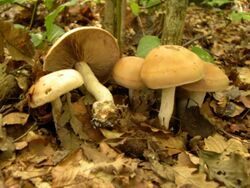Biology:Hebeloma sinapizans
| Hebeloma sinapizans | |
|---|---|

| |
| Scientific classification | |
| Domain: | Eukaryota |
| Kingdom: | Fungi |
| Division: | Basidiomycota |
| Class: | Agaricomycetes |
| Order: | Agaricales |
| Family: | Hymenogastraceae |
| Genus: | Hebeloma |
| Species: | H. sinapizans
|
| Binomial name | |
| Hebeloma sinapizans (Paulet) Gillet (1878)
| |
| Synonyms[1] | |
| |
Hebeloma sinapizans, commonly known as the scaly-stalked heboloma,[2] rough-stalked hebeloma or the bitter poisonpie, is a species of mushroom in the family Hymenogastraceae. It has a strong radish-like smell and a prominent bulbous stem base. H. sinapizans is found in Europe and North America and is poisonous.
Taxonomy
First described as Hypophyllum sinapizans by Jean-Jacques Paulet in 1793,[3] it was transferred to the genus Hebeloma by Claude Casimir Gillet in 1878.[4] It is commonly known as the "rough-stalked Hebeloma".[5]
Description
The fruit body has a cap that is initially convex before flattening out in age, reaching a diameter of 4–15.5 centimetres (1 1⁄2–6 inches). The cap may have a shallow umbo. The cap surface ranges from moist to sticky, and it is smooth with a margin that is first curled inward and expanding to become curled upward in maturity; the cap color is whitish-tan to cinnamon-tan, sometimes with pinkish- or reddish-brown tints. The flesh is whitish, thick, and has a radish-like odor and taste. Gills have an adnate attachment to the stipe, and they have a notch just before the point of attachment; the gill edges have tiny fringes or serrations. They are first whitish before turning to yellowish-brown to pale brown after the spores mature.
The stipe measures 2–5 cm (1–2 in) long by 1.3–2.5 cm (1⁄2–1 in) thick, and is roughly equal in width throughout its length.[5]
Fruit bodies produce a pale brown spore print. Spores are elliptical with a rough surface texture, and measure 10–14 by 6–8 µm.[5]
Similar species
It is similar to the more common H. crustuliniforme, a smaller relative that is also poisonous.
Distribution and habitat
As of December 2022, the species has been found in 20 countries across Europe as well as in Asiatic Turkey and Lebanon.[6]
The fungus fruits on the ground in groups or fairy rings in deciduous and coniferous forests.[5]
Toxicity
H. sinapizans mushrooms are poisonous.[5]
See also
References
| Hebeloma sinapizans | |
|---|---|
| Mycological characteristics | |
| gills on hymenium | |
| cap is convex | |
| hymenium is adnexed | |
| lacks a stipe | |
| spore print is brown | |
| ecology is mycorrhizal | |
| edibility: poisonous | |
- ↑ "Hebeloma sinapizans (Paulet) Gillet, Les Hyménomycètes ou Description de tous les Champignons qui Croissent en France: 527, 1878". MycoBank. International Mycological Association. http://www.mycobank.org/BioloMICS.aspx?Table=Mycobank&Rec=12518&Fields=All.
- ↑ Arora, David (1986). Mushrooms demystified: a comprehensive guide to the fleshy fungi (Second ed.). Berkeley: Ten Speed Press. p. 465. ISBN 978-0-89815-169-5.
- ↑ Paulet JJ. (1793) (in French). Traité des champignons. 2. Paris: Louvre. plate 82.
- ↑ Gillet CC. (1878) (in French). Les Hyménomycètes ou Description de tous les Champignons qui Croissent en France. Alençon: Ch. Thomas. p. 527.
- ↑ 5.0 5.1 5.2 5.3 5.4 Mushrooms of the Southeastern United States. Syracuse: Syracuse University Press. 2007. p. 137. ISBN 978-0-8156-3112-5. https://books.google.com/books?id=IB1Gv3jZMmAC&pg=PA137.
- ↑ "Hebeloma sinapizans". https://hebeloma.org/species/sinapizans.
Wikidata ☰ Q2714643 entry
 |

